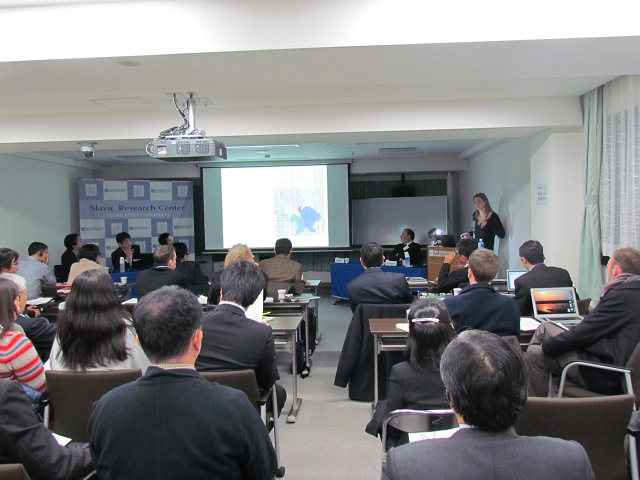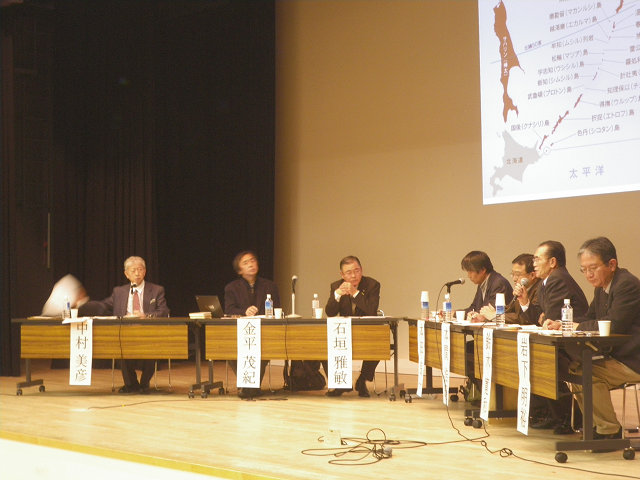
Notes on the Global COE Winter Symposium
2011/11/30
On November 26th, Hokkaido University°«s Global COE Program hosted its third International Winter Symposium. As in previous years, an introductory speech from our Program Leader, Professor Akihiro Iwashita, was followed by a session with a theoretical remit, while the afternoon saw two sessions on °∆Borders and Development in South-East Asia°« and °∆Divided spaces°« that between them covered a great deal of thematic and geographical ground. This year's theoretical session saw presentations by two leaders in the field of Border Studies, with a North American perspective provided by Professor Tony Payan and a European one from Professor James Scott. North America incorporates the most studied borders in the field, those between the US and Canada and the US and Mexico, while through EU-led integration, Europe is a region re-envisaging the meaning of a °∆border°«. Both Professor°«s drew upon their own research and, through theoretical and comparative engagement, provided a keen critique of the state of the °∆Border Studies°« field.
 Interspersed with a trip to the 'China seen from across the border' Media Exhibition at the Hokkaido University Museum and the Luncheon Seminar, participants reconvened in the afternoon for the °∆Borders and Development in South-East Asia°« session. The three papers focused on issues surrounding the damming of the Mekong River, population movements in North-East India and Cambodia's International relations . Based on intensive research in the regions concerned, these presentations not only proved a rich source of detailed information but succeeded in imparting something of the atmosphere of the areas they described.
Interspersed with a trip to the 'China seen from across the border' Media Exhibition at the Hokkaido University Museum and the Luncheon Seminar, participants reconvened in the afternoon for the °∆Borders and Development in South-East Asia°« session. The three papers focused on issues surrounding the damming of the Mekong River, population movements in North-East India and Cambodia's International relations . Based on intensive research in the regions concerned, these presentations not only proved a rich source of detailed information but succeeded in imparting something of the atmosphere of the areas they described.
The final session consisted of presentations drawn from research in a variety of °∆Divided Spaces°«; Jerusalem in Israel, Mostar in Bosnia-Herzegovinia, Ireland and Okinawa. Unfortunately, for family reasons Professor Haim Jacobi was unable to attend, so Professor Taizo Imano of Osaka City University stepped in to present his own research and explain the pattern of division within the city of Jerusalem. The study of Mostar was from the perspective of Urban Architecture, that on Ireland was an historical study over a long-span, while recent issues surrounding the potential move of an American Naval Base in Okinawa rounded off the panel. The discussant commented that perhaps there was a need to consider the basis and methods by which such empirical cases can be compared with others on a global scale. Such a comment mirrors that often made by students of comparative politics against area studies, and is particularly pertinent for our Slavic Research Center given its area studies vocation.
 The symposium was conducted in simultaneous translation in Japanese and English, and provided an excellent opportunity for the participants and attendees of the following days°« °∆Debate on the Northern Territories Dispute°« to be made aware of discussions in the °∆Border Studies°« field. The °∆Debate°« itself was held on the afternoon of the 27th at Sapporo°«s L-Plaza Hall, under the auspices of the Global COE program. It was chaired by the journalist Nakamura Yoshihiko, and with panelists including the TBS presenter Kanehira Shigenori vigorously debating the °∆Present and Possibilities°« of the Northern Territories Issue, the audience of around 150 were treated to a battle of experts familiar with both the Russian and Japanese viewpoints.
The symposium was conducted in simultaneous translation in Japanese and English, and provided an excellent opportunity for the participants and attendees of the following days°« °∆Debate on the Northern Territories Dispute°« to be made aware of discussions in the °∆Border Studies°« field. The °∆Debate°« itself was held on the afternoon of the 27th at Sapporo°«s L-Plaza Hall, under the auspices of the Global COE program. It was chaired by the journalist Nakamura Yoshihiko, and with panelists including the TBS presenter Kanehira Shigenori vigorously debating the °∆Present and Possibilities°« of the Northern Territories Issue, the audience of around 150 were treated to a battle of experts familiar with both the Russian and Japanese viewpoints.
 Interspersed with a trip to the 'China seen from across the border' Media Exhibition at the Hokkaido University Museum and the Luncheon Seminar, participants reconvened in the afternoon for the °∆Borders and Development in South-East Asia°« session. The three papers focused on issues surrounding the damming of the Mekong River, population movements in North-East India and Cambodia's International relations . Based on intensive research in the regions concerned, these presentations not only proved a rich source of detailed information but succeeded in imparting something of the atmosphere of the areas they described.
Interspersed with a trip to the 'China seen from across the border' Media Exhibition at the Hokkaido University Museum and the Luncheon Seminar, participants reconvened in the afternoon for the °∆Borders and Development in South-East Asia°« session. The three papers focused on issues surrounding the damming of the Mekong River, population movements in North-East India and Cambodia's International relations . Based on intensive research in the regions concerned, these presentations not only proved a rich source of detailed information but succeeded in imparting something of the atmosphere of the areas they described.The final session consisted of presentations drawn from research in a variety of °∆Divided Spaces°«; Jerusalem in Israel, Mostar in Bosnia-Herzegovinia, Ireland and Okinawa. Unfortunately, for family reasons Professor Haim Jacobi was unable to attend, so Professor Taizo Imano of Osaka City University stepped in to present his own research and explain the pattern of division within the city of Jerusalem. The study of Mostar was from the perspective of Urban Architecture, that on Ireland was an historical study over a long-span, while recent issues surrounding the potential move of an American Naval Base in Okinawa rounded off the panel. The discussant commented that perhaps there was a need to consider the basis and methods by which such empirical cases can be compared with others on a global scale. Such a comment mirrors that often made by students of comparative politics against area studies, and is particularly pertinent for our Slavic Research Center given its area studies vocation.
 The symposium was conducted in simultaneous translation in Japanese and English, and provided an excellent opportunity for the participants and attendees of the following days°« °∆Debate on the Northern Territories Dispute°« to be made aware of discussions in the °∆Border Studies°« field. The °∆Debate°« itself was held on the afternoon of the 27th at Sapporo°«s L-Plaza Hall, under the auspices of the Global COE program. It was chaired by the journalist Nakamura Yoshihiko, and with panelists including the TBS presenter Kanehira Shigenori vigorously debating the °∆Present and Possibilities°« of the Northern Territories Issue, the audience of around 150 were treated to a battle of experts familiar with both the Russian and Japanese viewpoints.
The symposium was conducted in simultaneous translation in Japanese and English, and provided an excellent opportunity for the participants and attendees of the following days°« °∆Debate on the Northern Territories Dispute°« to be made aware of discussions in the °∆Border Studies°« field. The °∆Debate°« itself was held on the afternoon of the 27th at Sapporo°«s L-Plaza Hall, under the auspices of the Global COE program. It was chaired by the journalist Nakamura Yoshihiko, and with panelists including the TBS presenter Kanehira Shigenori vigorously debating the °∆Present and Possibilities°« of the Northern Territories Issue, the audience of around 150 were treated to a battle of experts familiar with both the Russian and Japanese viewpoints.





